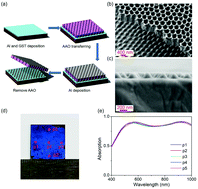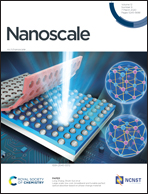Large-scale, low-cost, broadband and tunable perfect optical absorber based on phase-change material†
Abstract
Metamaterial-based electromagnetic absorbers have attracted much attention recently, but most previous realizations suffer from issues of narrow bandwidth, time-consuming and high-cost fabrication methods, and/or fixed functionalities, and so are unfavorable for practical applications. Here, we demonstrate experimentally a large-scale, broadband, polarization-independent, and tunable metamaterial absorber, which works for both visible and near-infrared light. A lithography-free and low-cost method was utilized to fabricate a centimeter-sized metamaterial sample in a metal–insulator–metal (MIM) configuration with nano-scale precision, in which a phase-change material, Ge2Sb2Te5 (GST), was adopted as the insulating spacer of the MIM structure. With two different resonance mechanisms working together, the proposed device was shown to exhibit high absorptivity (>80%) within a broad wavelength band (480–1020 nm). By thermally tuning the phase state of the GST layer, we can dramatically enlarge the working bandwidth of the metamaterial absorber by shifting one absorption peak by about 470 nm. These findings may stimulate many potential applications in, for example, solar cells, energy harvesting, smart sensing/imaging, and color printing.



 Please wait while we load your content...
Please wait while we load your content...